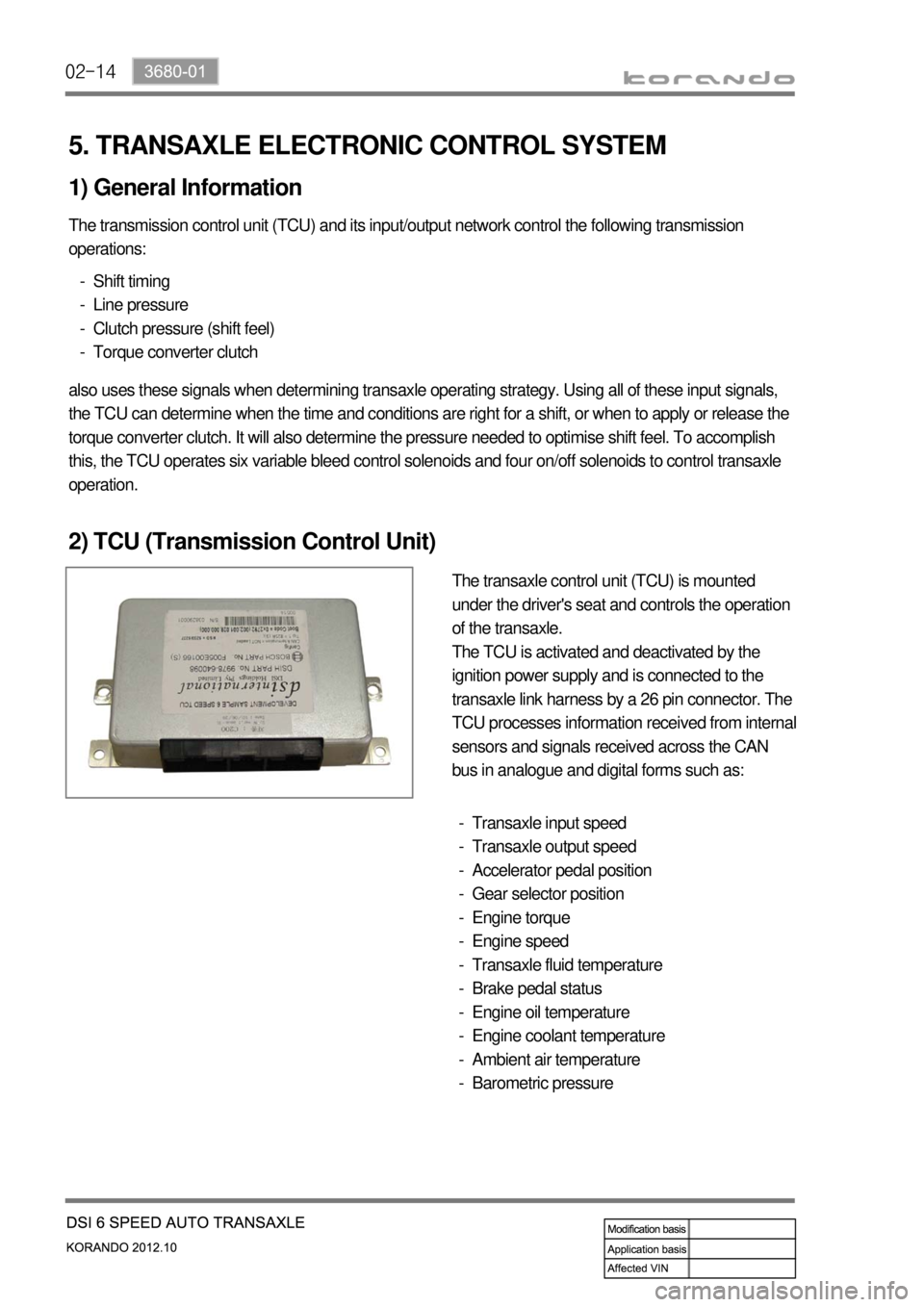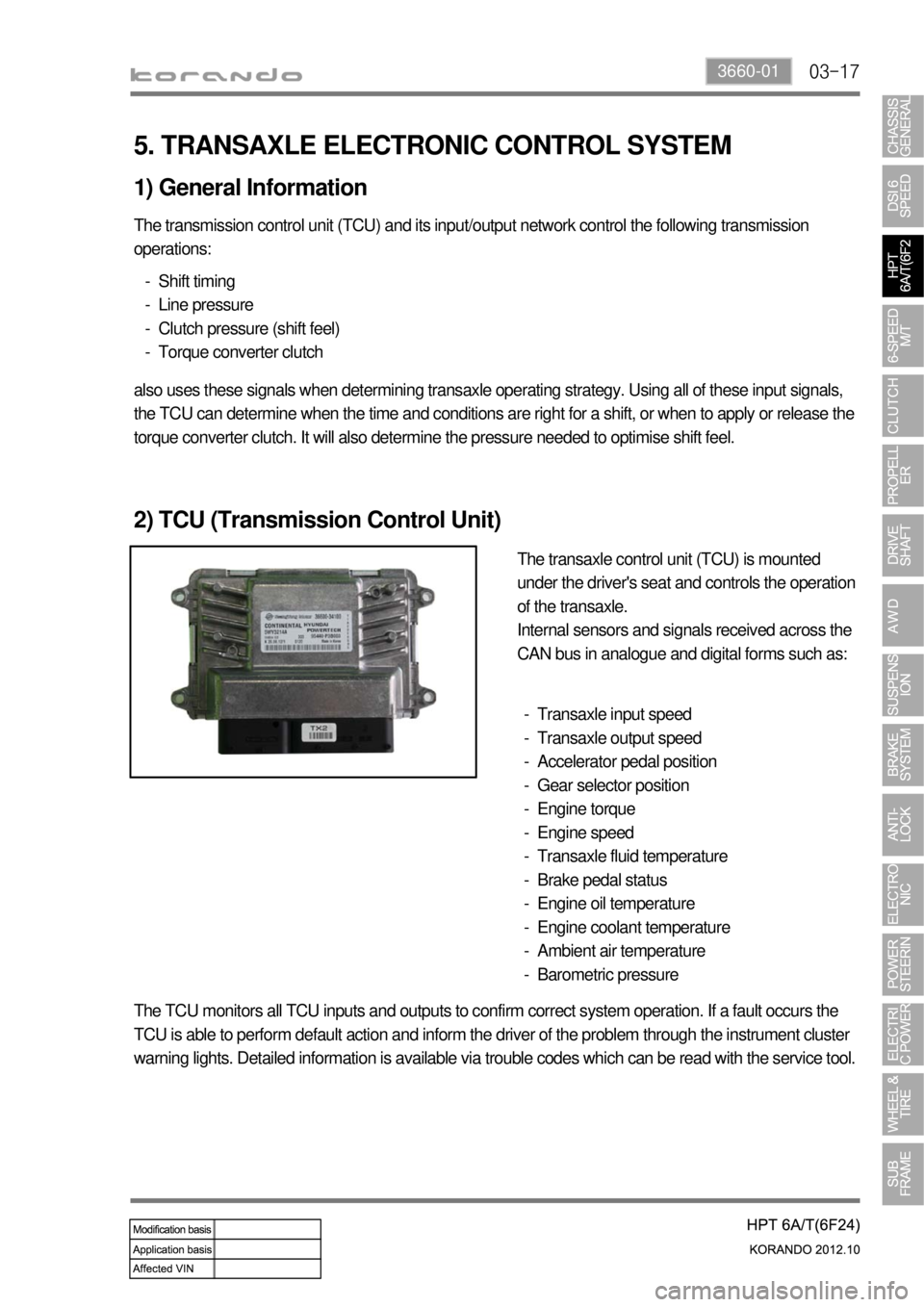Page 481 of 1082
15-16
5) Warm-Up of Catalytic Converter
(1) Components
Input Components ▶
T-MAP sensorCoolant temperature
sensorCrankshaft position
sensor
Output Components ▶
Page 482 of 1082

15-170000-00
(2) Warm-up Control Function
Low voltage ▶
If low voltage is detected by the ECU, the idle speed increases up to 100 rpm selectively under the
driving mode until the ignition switch is turned off. Idle speed control ▶
The idle speed is controlled according to the fuel/air mixture when the engine load is changed, the
power steering wheel is turned to its end, the selector lever is in the "D" position and the A/C compresso
r
is in operation. It is also controlled according to the charge level during the purge control operation.
Ignition timing ▶
The idle speed is controlled according to the fuel/air mixture when the engine load is changed, The
<0090008e00950090009b009000960095004700880095008e0093008c0047008a0088009500470089008c00470099008c009b00880099008b008c008b0047009c00970047009b00960047005a005d020b00470096009900470088008b009d00880095008a00
8c008b0047009c00970047009b0096004700590057020b0047>to help idle speed control.
Air conditioner compressor operation ▶
The air conditioner control unit sends the air conditioner operation signal to the ECU to increase the
throttle valve opening amount in order to prevent reduction of the engine speed when the air conditioner
compressor is in operation at idling.
(3) Warm-up Control Operating Conditions
To make the catalytic converter reach a operating temperature, the ignition timing is retarded for about
20 seconds under the following conditions:
The coolant temperature is 15°C ~ 40°C when the engine is started.
The selector lever is in the "P" or "N" position. ▶
▶
Also, the idle speed increases to 1100 ~ 1500 rpm simultaneously by the idle speed control. However, as
soon as the selector lever is shifted to the D position, warming up control of the catalytic converter will be
inhibited. The information necessary to perform such control is as follows:
Coolant temperature
Engine rpm
Intake air mass
Recognizing idling status
Selector lever position ▶
▶
▶
▶
▶
Page 483 of 1082
15-18
6) Cooling Fan Control
(1) Overview of Cooling Fan and A/C Compressor
The cooling system maintains the engine temperature at an efficient level during all engine operating
conditions. The water pump draws the coolant from the radiator. The coolant then circulates through
water jackets in the engine block, the intake manifold, and the cylinder head. When the coolant reaches
the operating temperature of the thermostat, the thermostat opens. The coolant then goes back to the
radiator where it cools. The heat from automatic transaxle is also cooled down through the radiator by
circulating the oil through the oil pump. There are two cooling fans (180W+120W) in G20DF engine. ECU
controls the electric cooling fans with three cooling fan relays to improve the engine torque and air
conditioning performance.
(2) Components
Refrigerant pressure
sensorCoolant temperature
sensorG20DF Engine
ECURelay box in engine
compartment
A/C compressorCooling fan moduleT-MAP sensor
Page 485 of 1082

15-20
(4) Cooling Fan and A/C Compressor Control
Conditions for cooling fan ▶
The cooling fan module controls the cooling fan relay, high speed relay and low speed relay.
The cooling fan is controlled by the series and parallel circuits
A/C
switchCooling
fanCoolant temperatureRefrigerant
pressureA/C
compressor
OFFOFFCoolant temp.<90℃-
LO90℃≤Coolant temp.<105℃-
HI105℃≤Coolant temp.-
ONLO
Coolant temp.<105℃Refrigerant
pressure<18 bar
ON
HI18 bar≤Refrigerant
pressure
HI105℃≤Coolant temp.<115℃-
HI115℃≤Coolant temp.- OFF (cut)
A/C compressor OFF conditions ▶
Coolant temperature: over 118℃
Approx. 4 seconds after starting the engine
When abrupt acceleration
Refrigerant pressure:
* OFF below 2.0 kg/㎠, then ON over 2.4 kg/㎠
* OFF over 32 kg/㎠, then ON below 26.0 kg/㎠ -
-
-
-
Output voltage according to refrigerant pressure ▶
The output voltage from refrigerant pressure sensor is 1.7 V to 3.5 V when the refrigerant pressure is 10
to 24 kgf/㎠ with A/C "ON".
Cooling fan control by ATF temperature ▶
ATF temperature Cooling fan speed Remark
Over 110˚CHI -
Page 731 of 1082

06-20
Temperature dial
In full AUTO mode, the FATC receives various signals
such as the indoor temperature, ambient temperature,
engine coolant temperature, sunlight, from different
sensors to control the A/C compressor, mode door, intake
actuator assembly, air mix door, blower motors, etc. to
keep indoor environments fresh.
Fan speed dial
In full AUTO mode, the blower
motor is controlled
automatically according to the
set temperature. The blower
motor speed can also be
controlled manually.Mode dial
You can choose a desired
mode from the 5 modes by
turning the mode as required.
The dial indicator for the
selected mode comes on to
inform the operator.
Air source mode switch
When you press this switch,
recirculation indicator comes on and
the system is changed into the
recirculation mode. (However, under
defroster
mode or defroster/floor mode, it stays
in the fresh air mode.)
A/C switch
When pressing this switch, the
air conditioner operates in
manual mode and A/C ON
indicator comes on.
The A/C starts automatically
when the defroster mode is
selected.
Page 848 of 1082

02-14
5. TRANSAXLE ELECTRONIC CONTROL SYSTEM
1) General Information
The transmission control unit (TCU) and its input/output network control the following transmission
operations:
Shift timing
Line pressure
Clutch pressure (shift feel)
Torque converter clutch -
-
-
-
also uses these signals when determining transaxle operating strategy. Using all of these input signals,
the TCU can determine when the time and conditions are right for a shift, or when to apply or release the
torque converter clutch. It will also determine the pressure needed to optimise shift feel. To accomplish
this, the TCU operates six variable bleed control solenoids and four on/off solenoids to control transaxle
operation.
2) TCU (Transmission Control Unit)
The transaxle control unit (TCU) is mounted
under the driver's seat and controls the operation
of the transaxle.
The TCU is activated and deactivated by the
ignition power supply and is connected to the
transaxle link harness by a 26 pin connector. The
TCU processes information received from internal
sensors and signals received across the CAN
bus in analogue and digital forms such as:
Transaxle input speed
Transaxle output speed
Accelerator pedal position
Gear selector position
Engine torque
Engine speed
Transaxle fluid temperature
Brake pedal status
Engine oil temperature
Engine coolant temperature
Ambient air temperature
Barometric pressure -
-
-
-
-
-
-
-
-
-
-
-
Page 877 of 1082

03-173660-01
5. TRANSAXLE ELECTRONIC CONTROL SYSTEM
1) General Information
The transmission control unit (TCU) and its input/output network control the following transmission
operations:
Shift timing
Line pressure
Clutch pressure (shift feel)
Torque converter clutch -
-
-
-
also uses these signals when determining transaxle operating strategy. Using all of these input signals,
the TCU can determine when the time and conditions are right for a shift, or when to apply or release the
torque converter clutch. It will also determine the pressure needed to optimise shift feel.
2) TCU (Transmission Control Unit)
The transaxle control unit (TCU) is mounted
under the driver's seat and controls the operation
of the transaxle.
Internal sensors and signals received across the
CAN bus in analogue and digital forms such as:
Transaxle input speed
Transaxle output speed
Accelerator pedal position
Gear selector position
Engine torque
Engine speed
Transaxle fluid temperature
Brake pedal status
Engine oil temperature
Engine coolant temperature
Ambient air temperature
Barometric pressure -
-
-
-
-
-
-
-
-
-
-
-
The TCU monitors all TCU inputs and outputs to confirm correct system operation. If a fault occurs the
TCU is able to perform default action and inform the driver of the problem through the instrument cluster
warning lights. Detailed information is available via trouble codes which can be read with the service tool.